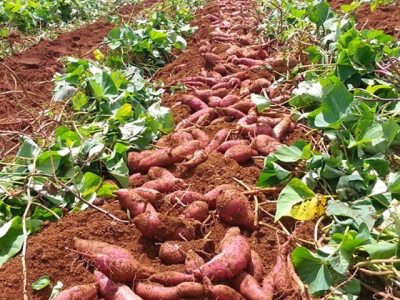Taking your sweet potatoes through to maturity

Even though sweet POTATOES are a generally low-care crop, some pests can cause a complete wipe-out. You need to do regular inspections and know what to look for.
Sweet potatoes bagged and ready for market.
A few pests, including hawk moth larvae, resemble the caterpillars of the mopani moth (Gonimbrasia belina). Very often birds will be the first to discover these. If there are enough birds relative to the pest causing the damage, they will solve the problem better than you could. When I discovered these caterpillars, l’d let the labourers know. They picked them off and dried them like mopani caterpillars, and everyone was a winner.
This same caterpillar saved a crop for me years ago when I ploughed a land I thought was virgin veld. I planted maize and herbicide controlled everything, apart from a massive growth of Convolvulus arvensis, a distant relative of the sweet potato. I found these caterpillars eating this weed in the land, cleaning it up with no labour required.
There is a small leaf-mining caterpillar that makes “windows” on the leaves and usually requires a systemic product for adequate control. The windows make this is an easy pest to notice, and are made as the caterpillars eat the leaf from the inside, leaving the upper and lower epidermis intact. These caterpillars build up gradually, unlike the larger species just described.
The evil weevil
Perhaps the most dangerous pest is the sweet potato weevil, which is a few millimetres long and black in colour. Scout for this pest, which is only obvious when it has already done much damage. It lays its eggs on roots exposed either where they grow out of the soil or where the soil is cracked. These weevils can also infect the roots, laying their eggs on stems close to the ground where their larvae tunnel down into the roots. The weevil tunnels a cavity into the stem or root, lays an egg and then seals it in. With their tunnelling, their larvae render the roots unmarketable. Unless you inspect the crop closely, you can easily be caught unawares.
The adult weevils can sometimes be seen foraging on the leaves, but neither they nor their damage are conspicuous. The roots must be examined, especially where they have become exposed. The weevils work on roots from the top down, so this is where you need to look for them. The life cycle is just over a month in warm conditions so they can multiply rapidly.
The weevil can also be introduced through planting material. Where there’s a risk of this, the runners can be sprayed with a suitable insecticide before harvesting, or dipped in a drum containing the insecticide before being placed in the land. The last thing you need is to introduce this pest where it didn’t occur before.
Harvesting sweet potatoes
Harvest sweet potatoes with a potato or sweet potato lifter. This is a flat plate fitted to a ripper tine, with strips of round bar welded to it. It lets the soil pass through, leaving the tubers on the surface for a few days to cure. But don’t leave them out if there’s a possibility of rain or very strong sun, which may cause burn.
Try get the harvested tubers through the packhouse before the soil adgering to them dries out and is harder to remove. Take great care to prevent cutting and bruising, which will greatly shorten the shelf life. Market them in bags that compliment the skin colour.
Related news
 Using radish to control cyst eelworm
Using radish to control cyst eelworm A fodder radish crop can exterminate up to 95% of a cyst eelworm population and be used for biofumigation, writes Bill Kerr.
 10 Summer Squash Varieties: Some You Know, Some You Don’t
10 Summer Squash Varieties: Some You Know, Some You Don’t There are hundreds of varieties of summer squash, ranging from dark green to bright yellow, long to stubby, smooth to lumpy to ridged. It's a complicated family
 7 Gourmet Vegetables to Plant Now for Fall Harvest
7 Gourmet Vegetables to Plant Now for Fall Harvest Broccoli, lettuce, kale, arugula, radishes most gardeners know these “cool season” crops fail to thrive in summer but also grow crisp and tasty